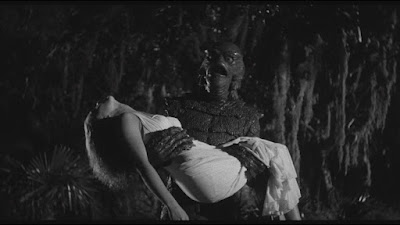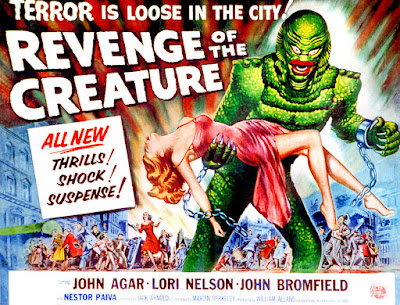"
Revenge of the Creature"
** (out of ****)
"We must also be alert to the equal and opposite danger that public policy could itself become the captive of a scientific-technological elite."
President Dwight Eisenhower - Farewell Address (1961)
When Americans think of former President Eisenhower's Farewell Address they quote his comments regarding the "Military Industrial Complex" but Eisenhower also warned the nation about science. The 1950s saw a great skepticism around scientific research thanks to the Atomic Age. It may seem like a stretch but "Revenge of the Creature" (1955) makes a similar commentary, albeit in a less eloquent manner, while drawing a connection between commercialism and science.
Universal Picture's "Revenge of the Creature" is a sequel to "The Creature From the Black Lagoon" (1954), which was also a cautionary tale rallying on the dangers of scientific exploration. Both movies follow in the grand legacy of Universal's Monster movies - "Dracula" (1931), "Frankenstein" (1931), and "The Mummy" (1932) - which admonished society's scientific curiosity, man's desire to play God, and a lack of respect for different cultures and tradition. The Gill-Man is often credited as being the last creation in Universal's Monster franchise.
Unfortunately, by the time Universal released the "Creature" movies - a final sequel followed this movie, "The Creature Walks Among Us" (1956) - Universal had regulated its horror movies to their "B" division which saw a dramatic decline in production and costume design as well as visual aesthetic. It's a sad story how quickly Universal ruined their franchises by creating needless sequels and reboots - they created a completely unnecessary "Mummy" reboot and three additional sequels - to desperate marketing gimmicks such as creating Monster mash-ups where several Universal Monsters would all appear together in the same movie. By the time the Gill-Man and the 1950s came along, the Monsters were a tired and old entity that had been Abbott & Costello-ed out. Somehow the Gill-Man has gained popularity but the movies are poorly made and forgettable. I hate to sound like a politician but throwing some money at this problem would have gone a long way. There is tremendous potential for this series if it were done correctly.
Like so many other sequels, "Revenge of the Creature" is an unoriginal retread of the original movie, establishing the same predicaments around similar characters. This time however an element of "King Kong" (1933) is added to the story with the new twist being, the Gill-Man is brought into the modern world, where he / it is put on exhibit at a SeaWorld like attraction. The absurdity of this situation, while perhaps somewhat likely, must be a critique of commercialism and science. Why on earth would the Gill-Man be captured and brought to America, just so it could be a theme park attraction. Wouldn't such a discovery be kept hidden from the public and isolated in a lab where scientists could perform studies on it?
The story begins a year after the events of "The Creature From the Black Lagoon" with Joe Hayes (John Bromfield) and George Johnson (Robert Williams) traveling to the Amazon on the behalf of an institution called Ocean Harbor. Their orders are to capture the Gill-Man and bring him back to America. The wisdom of this idea is challenged by one of the locals, their guide (Nestor Paiva) reprising his role from the first movie. While informing the men of the incidents from the prior year, the sequence also serves as a commentary on outsiders (Americans) showing no respect for mythology, history, and science. What is the point, the guide ask, of capturing this creature? "To please some crazy scientists?" he suggestively mocks. Even if it will cost them their lives? But the question must also be asked, if the guide knew of the danger, why would he agree to ever take anyone back there?

After catching the Gill-Man and bringing him / it back to America, we are introduced to Professor Clete Ferguson (John Agar), who has been conducting research comparing the intelligence of apes to humans, and ichthyologist Helen Dobson (Lori Nelson). She will play "beauty" to the Gill-Man's "beast". As in "King Kong" and the first "Creature" movie, the Gill-Man has an eye for the ladies and becomes attracted to her, creating a kind of love triangle between Clete, Helen, and The Gill-Man.
The Professor and Helen work together performing conditioned behavior experiments on the Gill-Man by zapping him with a cattle prog for each incorrect response. These sequences are tedious at best and could have been displayed in a montage sequence instead of multiple scenes. We learn the Gill-Man is an intelligent creature that is almost human-like. Eventually, as the movie's poster tagline reveals, the Gill-Man gets loose and begins to terrorize the city. Although that is a slightly misleading interpretation.
One of my problems with the Gill-Man character is its appearance. It doesn't look scary to me and lacks the visual artistry of Frankenstein's Monster for example. It looks like an actor wearing a cheap rubber costume. My other issue with the character is it has way too much screen-time. The character makes an appearance approximately eight minutes into the movie and remains onscreen practically for the remainder of this 81 minute movie. By making the audience so accustom to the sight of the character it stops being a menacing, scary figure. This was the same mistake made in the first movie. The best example of how to handle something like this is found in Steven Spielberg's "Jaws" (1975), also about a terrifying creature in the water. Spielberg does a lot of build-up for the shark but waits nearly an hour into the movie to show us. That delay not only creates suspense and anticipation for the sight of the shark but also allowed the audience time to identify with the human characters. The "Creature" movies just want to go for the shock early on.
Also, because this is a "B" movie, the performances aren't very good. John Agar, who was briefly married to Shirley Temple, is a rather stiff and dull actor and not my idea of a leading man. He primarily worked on "B" movies throughout his career. He has no chemistry with Lori Nelson, whose performance is somewhat better, expressing a more natural quality.
Finally, and perhaps the most significant flaw of the movie, is the cinematography by Charles S Welbourne. The cinematography does practically nothing to create an eerie mood. The movie needed to be shot in the dark more - the last half of the movie is - and more needed to be done with lighting and shadows. The movie is too brightly lit. The heavy burden of creating the movie's atmosphere is all placed on the shoulder's of the movie's composer, who strangely goes uncredited. Online sources suggest the composer was Herman Stein. The movie only gives credit to "Music Supervision" by Joseph Gershenson.

Mind you none of this is to excuse the movie's screenplay by Martin Berkeley, who spent a lot of his career writing westerns. He awkwardly attempts to interject science into the dialogue, explaining the action of the characters. Like the performances, it is not natural and comes off as forced. One of the more interesting dialogue exchanges occurs when the Professor and Helen are discussing their possible future plans together. It hits on the social attitudes of the era commenting on how women must choose between starting a family or a career. The Professor, in a matter-of-fact way, states he's a man and doesn't have to worry about such things. Fittingly, Berkeley's next screenplay would be for another "B" horror / science-fiction movie, "Tarantula" (1955) also starring Agar and directed by this movie's director, Jack Arnold.
To further impress upon you the downfall of Universal's treatment of its once acclaimed horror movies, both "The Creature From the Black Lagoon" and this movie were shot in 3-D, which as is the case now, was a cash-grabbing exploitive gimmick. The movie has many underwater sequences, showing the Gill-Man swimming. You will notice at times, the character swims directly into the camera, this was done for 3-D purposes, which is lost on an audience watching the movie in 2-D. It looks like bad camera work to us today.
And yet despite the lousy cinematography, bad acting, and weak dialogue, the Gill-Man endures. These movies were successful at the box-office and have seeped into pop-culture. That makes it all the more disappointing to me. Since this is the "year of me" - my year long celebration of my favorite artists and filmmakers, in honor of my 40th birthday and the 15th anniversary of this blog - I will share with you, growing up my friends and I "loved" the Universal Monsters. Personally they scared me to death! But we collected action figures and other merchandise of the characters and would watch (or try to in my case) the movies repeatedly. The first movies introducing characters like Dracula, Frankenstein's Monster, the Mummy, and the Wolf-Man are pieces of wonderful entertainment. "Dracula" and "Frankenstein" in particular were made with great artistry and artistic merit. It is so unfortunate and maddening to me the Gill-Man couldn't receive similar treatment. Countless remakes have been hinted at over the years only for the productions to fall through. In the only time I will ever suggest such a thing, I must admit a modern retelling of these movies could be spectacular, as long as they keep modern day social identity politics out of it.
A lot of younger viewers probably became curious about these movies after Guillermo del Toro released the ridiculous "The Shape of Water" (2017), which embarrassingly won the Academy Award for best picture. It was heavily influenced by these movies but made the tragic mistake of turning the material into a love story, all so it could make a social commentary on illegal immigration (!). Naturally the sheep (AKA movie critics) ate it up. But it goes to prove how the original character and elements of the original story are still with us today and remain an influence, whether or not viewers are aware of it.
"Revenge of the Creature" is a goofy, cheap and exploitive movie. It is your typical "B" movie comprised of bad acting and forced dialogue. Its attempts at a social commentary are interesting but half-baked. It is doubtful this movie could scare modern day audiences. The most entertainment you can get out of this movie would be to get friends together and give it the old "Mystery Science 3000" treatment, where you talk over the movie and make wise-crack jokes. Spot Clint Eastwood in his uncredited movie debut as a lab assistant. He'd be back with much of this same gang in 'Tarantula".











